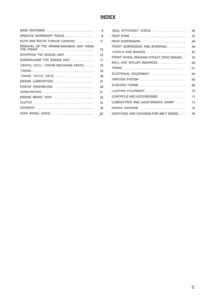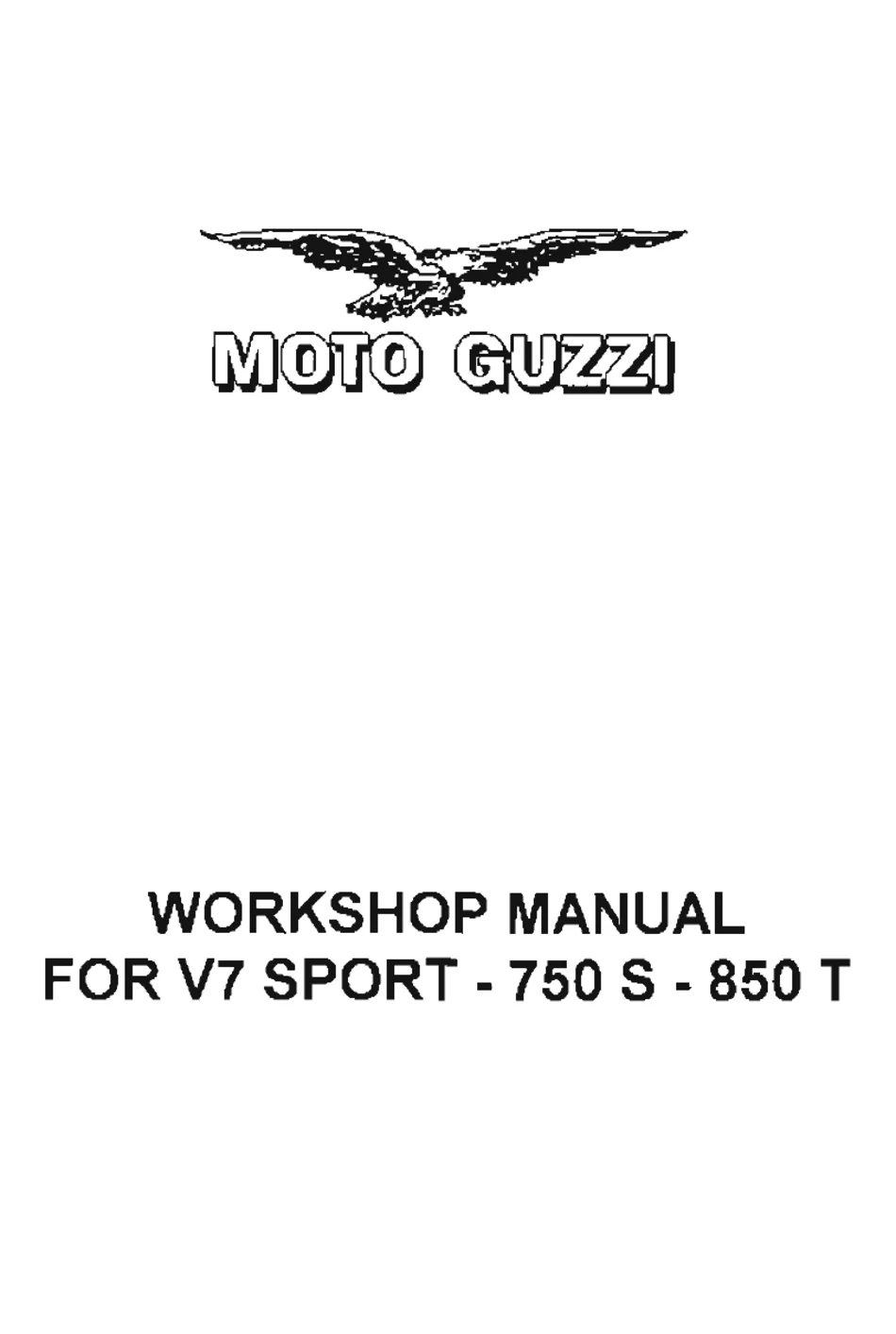Complete PDF version of the Service Manual for the Moto Guzzi V7 Sport 750/850. A MUST for every V7 Sport owner.
Download: Immediately after payment!
OEM Original factory workshop manual.
Models covered by this manual: 1971 to 1977
Number of pages: 135 pages
Table of contents:

This PDF repair manual can be downloaded right after the payment process in complete, on the device of your choice. You will also receive the download link by email along with your receipt.
We do not offer printed manuals, for the following reasons:
- it is more eco-friendly to use a digital version
- your manual never gets dirty or greasy
- you can always choose to print the specific page(s) you need to work on your bike
- you receive your manual immediately after payment
- it is searchable

Moto Guzzi V7 Sport
The Moto Guzzi V7 Sport was, in the seventies, a model of motorcycle flagship touring-sport Mandello. Popularly known as the “Dachshund”, it was produced by Moto Guzzi in the “V7 Sport 750” , “750 S” and “750-S3”, from 1971 to 1976.
In 1967, after a period of uncertainty due to the death of the founder Carlo Guzzi (which took place in 1964 ), the management of Moto Guzzi was taken over by SEIMM (Società Esigianato Industrie Moto Meccaniche), a company established by IMI , which tried to direct the production to the moped and to institutional supplies.
In 1968, while the “maxi-motorbike” market was beginning to suffer the growing affirmation of Japanese, SEIMM entrusted Lino Tonti with the development of the V-engine, built in 1965 by Giulio Cesare Carcano and inexplicably fired on the spot at the end of the the same year, when the controlled administration took office.
The intent of the new management (the “engineers”, as they were called in Guzzi), headed by the general manager Romolo De Stefani, was to regain a sporting image, heavily tarnished by the decade of competitive inactivity following the well-known abstention pact.
The task entrusted to Tonti was to create a model derived from production, which would satisfy the parameters of “750 cm³ – 200 kg – 200 km/h”.
The Beginning
The starting point was the “V7 700” model on which Tonti, assisted by Umberto Todero, Carcano’s historic “right hand man”, set to work creating a racing prototype which, in 1969, managed to conquer 19 world speed records.
Given the conditions, Moto Guzzi decided to start the program for the production of the “750” for sport touring on a wide range, entrusting its construction to the same technicians. It had to be a job of filing, but Tonti and Todero were not satisfied with the results obtained and completely modified the chassis, to give greater stiffness, redesigned the crankcase and changed suspensions and brakes .
The prototype phase was particularly difficult and suffered due to the strong trade union unrest, which began with the hot autumn, which in 1970 led several times to the strike and the picketing of the factory which prevented access even to the managers and technicians of the experience department. With a night blitz, aided by some trusted collaborators, Todero and Tonti transferred projects, equipment and materials to the cellar of the latter’s villa, where the construction of the new chassis was completed within the established time frame.
The “V7 Sport 750” descended, a very low bike, with 70 Hp, speed gearbox and universal joint final drive. Equipped with excellent road holding, it was capable of reaching speeds well above 200 km/h and covering 400 meters from a standing start in 13 seconds.
The “telaio rosso” (1971)
During the modification work on the production lines, necessary for the industrialization of the product, a pre-series of 150 units was created in the Moto Guzzi racing department, many of which were registered in September 1971, to be sent to the main dealerships.
These specimens, intended for display, for the tests of specialized magazines or for private riders in endurance races , had the frame painted red, instead of black as expected, in order to highlight what was considered the most innovative and valuable part. They were also distinguished by the ribless gearbox. It was a box derived from that for the 4-speed “V7 Special”, waiting for the castings for the new box to be prepared. In early 1972, the “red chassis” were the subject of a recall campaign for the replacement of the gearbox.
In the summer of 1971, also in anticipation of a future sports program, Tonti asked the driver Jarno Saarinen to carry out some tests with the second prototype, obtaining an unexpected support. After many laps of the track, Saarinen exposed the impressions to the technicians and dictated some changes, such as the shift to the left of the gear lever, which would have been necessary for his driving style. The test was not followed up by the decision of the Guzzi management, unwilling to invest in a high-level sports program and, above all, strongly opposed to hiring Saarinen, for fear that the cumbersome presence of the acclaimed Finnish would obscure the merit of the car.
In September 1971 the Brambilla-Mandracci riders, after having held the head of the Bol d’Or uninterrupted for over 10 hours, took a prestigious and unfortunate 3rd place, riding a “V7 Sport” with increased engine, progenitor of the “850 Le Mans “.
The “V7 Sport 750,” (1971 – 1974)
The new bike was presented to the public during the Milan cycle and motorcycle show in November 1971, arousing a great deal of interest among industry professionals and simple enthusiasts. Finally put on sale in January 1972, the “V7 Sport” immediately became the reference model for world production, in the sector of motorcycles dedicated to sport tourism, thanks to the characteristics of stability, speed and sturdiness, decidedly superior to the models of competing manufacturers. of those years.
In 1972, Motociclismo magazine organized a comparative test for the six maxi-motorcycle models considered to be the most representative of the moment, in strictly stock configuration (Ducati 750 GT, Honda CB 750 Four, Kawasaki 750 Mach IV, Laverda 750 SF, Suzuki GT 750). During the tests, which took place under the control of Franco Marchesani, dean of the FMI sports commissioners, the Moto Guzzi V7 Sport completed the complete journey of the Monza circuit, stopping the chronometers at a time of 2 ′ 02 ″ 47 which resulted, by far, the best of the session. Particularly significant was the abysmal gap of over 11 seconds per lap inflicted on the Kawasaki 750 Mach IV which, at the time, was popularly regarded as the ultimate in performance.
Also in Monza, in 1974, Abbondio Sciaresa took the “V7 Sport” to victory, after having won some important races, including that of Misano, in the same year, where he also won the fastest lap, competing against the fierce Laverda 750 SFC, Kawasaki 750 H2R and Norton 750 Commando PR.
Nevertheless, some criticisms were leveled at the savings choices that characterized the production of the “V7 Sport”, accused of not being up to the Japanese competition. The flaws were concentrated in the external appearance, or in the poor quality of the secondary components and controls, as well as in the adoption of the front drum brake, actually very advanced and efficient, but aesthetically obsolete. Moto Guzzi ran for cover by selling a kit, created in collaboration with Brembo, for the transformation of the front brake from a drum to a double disc which, despite the cost of 120,000 lire, sold out in a few months. The same kit was equipped with most of the “V7 Sport” for the US market, starting from 1973.
The real reason that prevented the “V7 Sport” from reaching the sales numbers it deserved, depended on the low production potential of the Moto Guzzi. The new company management, in the meantime taken over by Alejandro De Tomaso, was taken by surprise by the success of the model and preferred to direct the product towards the elite motorcycle market, rather than expand the production lines.
In the autumn of 1972, in fact, the delivery times for the “V7 Sport” exceeded three months and the list price was 1,480,000 lire: partially justified by the high technical and qualitative contents, but equally exorbitant compared to the two-cylinder models of equal cubage, Italian and foreign, offered by competing houses. For example, the model most requested by the Italian market, the Laverda 750 SF, was on sale for 1,020,000 lire.
Nevertheless, in just over two years, 3,541 examples of the “V7 Sport” were built and delivered, in addition to the 150 examples of the pre-series.
The “750 S” (1974 – 1975)
In 1974, with serious delay, the “V7 Sport” was equipped with the double disc at the front. Basically it is the only significant technical change made, but the operation was commercially underlined by new colors, side panels with a more modern line and by a saddle with a raised shank. The bike was called “750 S” and 1,204 examples were built (from chassis VK1 * 11111 * to VK1 * 12315 *).
The bike was available in two versions, one with a double orange diagonal band and the other with a double green band, both on a black background.
This color will also be used on the next S3 but with slightly different color tones.
During production, chromium-molybdenum steel (Acc. 25CrMo4 UNI 5332) was replaced with normalized steel (Acc. Aq 45) for the construction of the frame. The decision had already been taken in February 1973, but was implemented two years later, due to the exhaustion of stocks of the material.
The “750-S3” (1975 – 1976)
A little more than a year after the release of the previous version, the “750-S3” was presented as part of the theorized synergy of the Benelli-Guzzi group. The bike was equipped with the instrumentation and optical groups already used for all Benelli-Guzzi models born during the De Tomaso direction and, from a technical point of view, it was equipped with the triple disc integral braking system, patented by Moto Guzzi and already mounted on the “Idroconvert” and “T3” models. Also in homage to the standardization of components, the elimination of the exclusive and original two-piece height-adjustable handlebar and of the toolboxes, replaced with simple accumulator covers, should be noted.
The modification to the braking system, excellent for touring, strongly inhibited the sporting use of the bike and was heavily criticized by customers. Production ceased in 1976, after totaling 981 copies.
Source: Wikipedia

